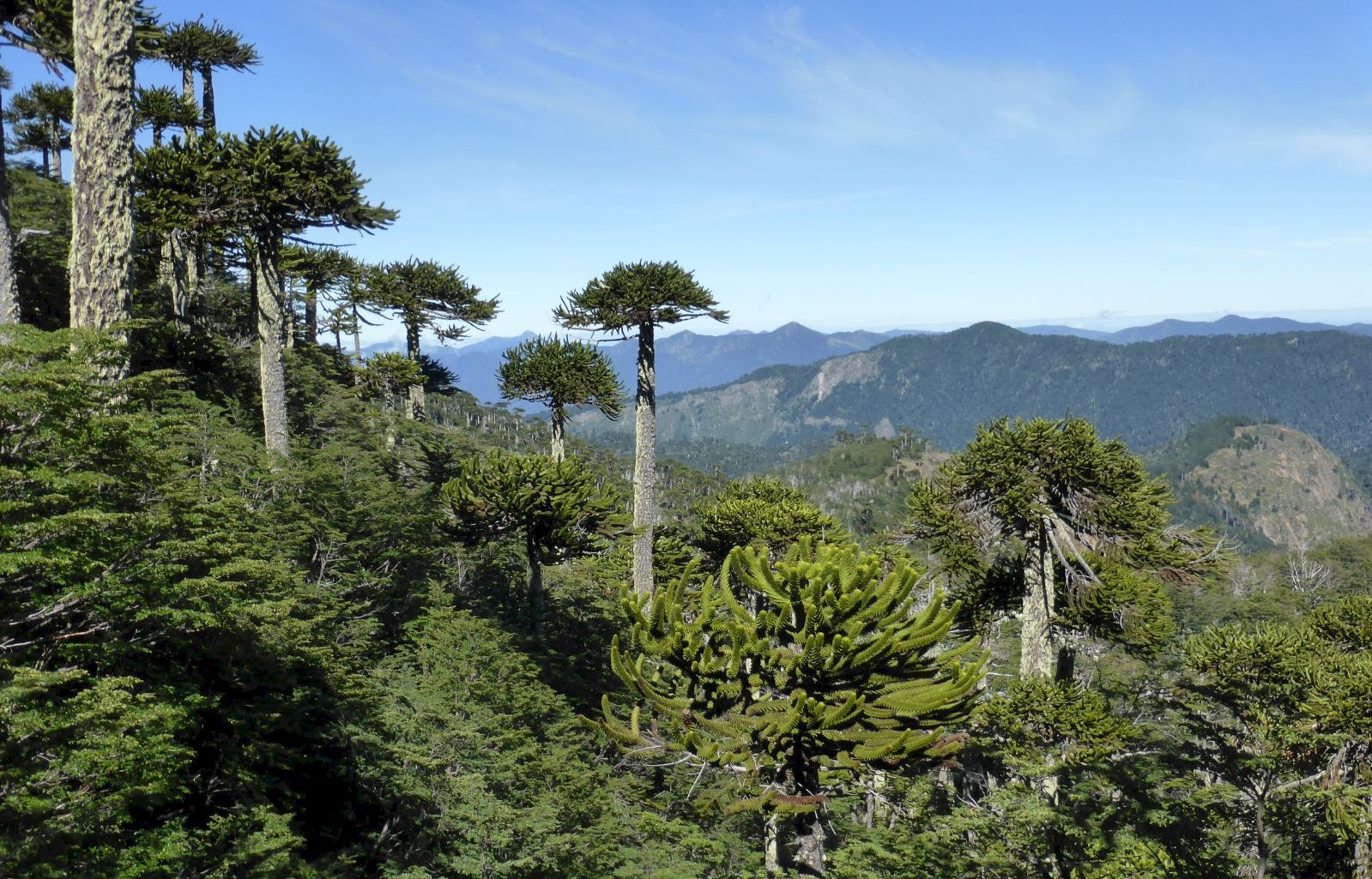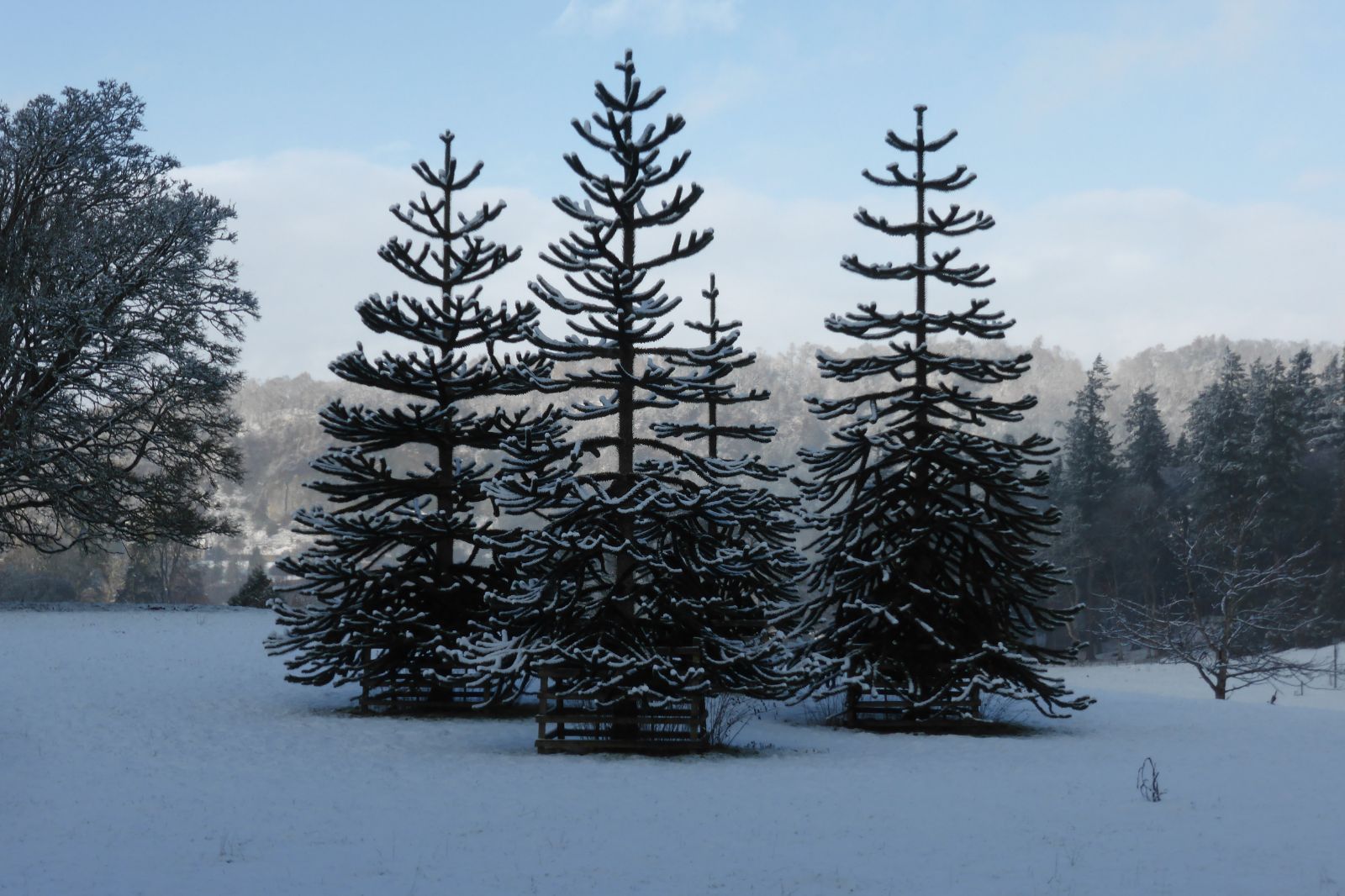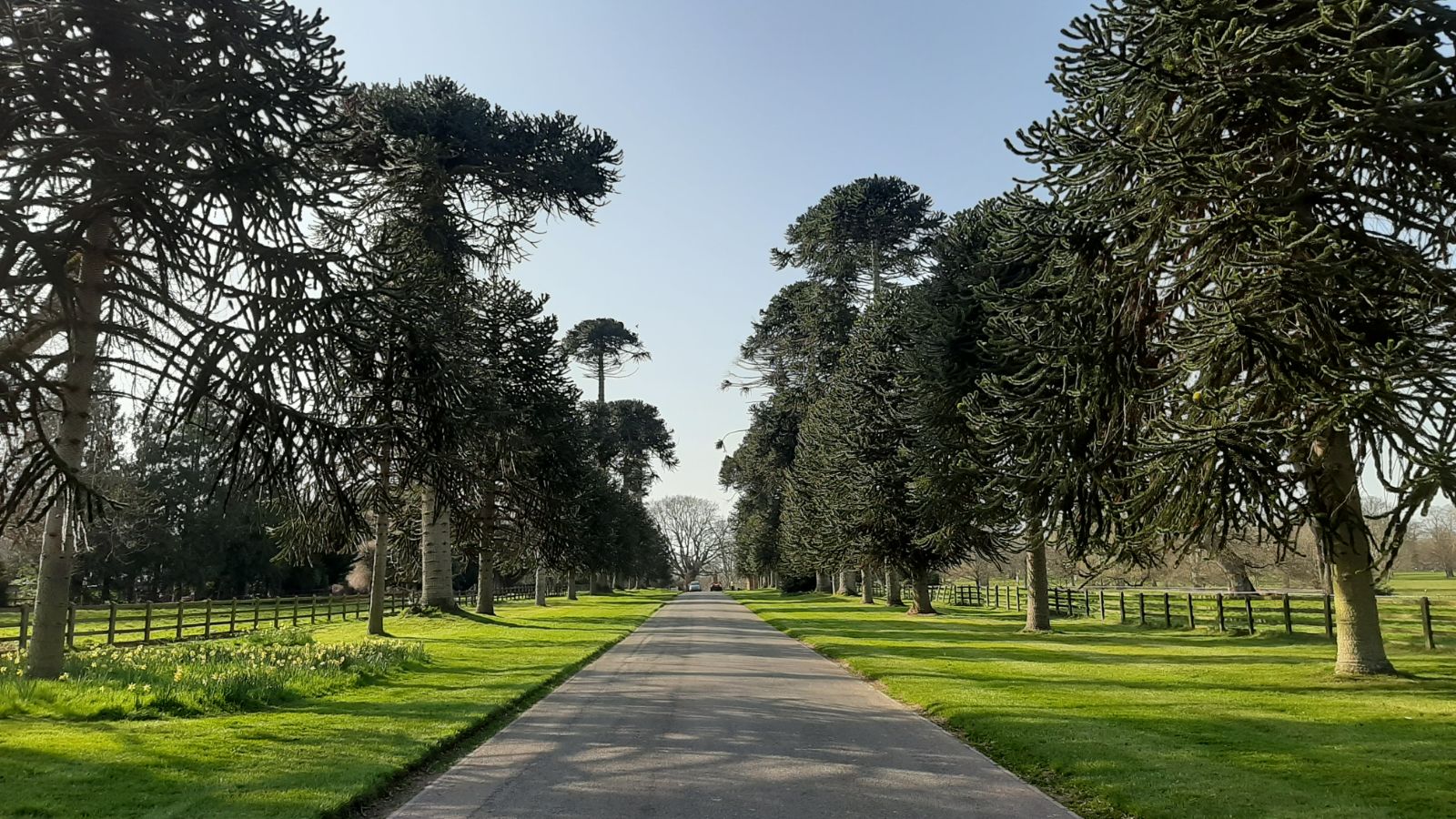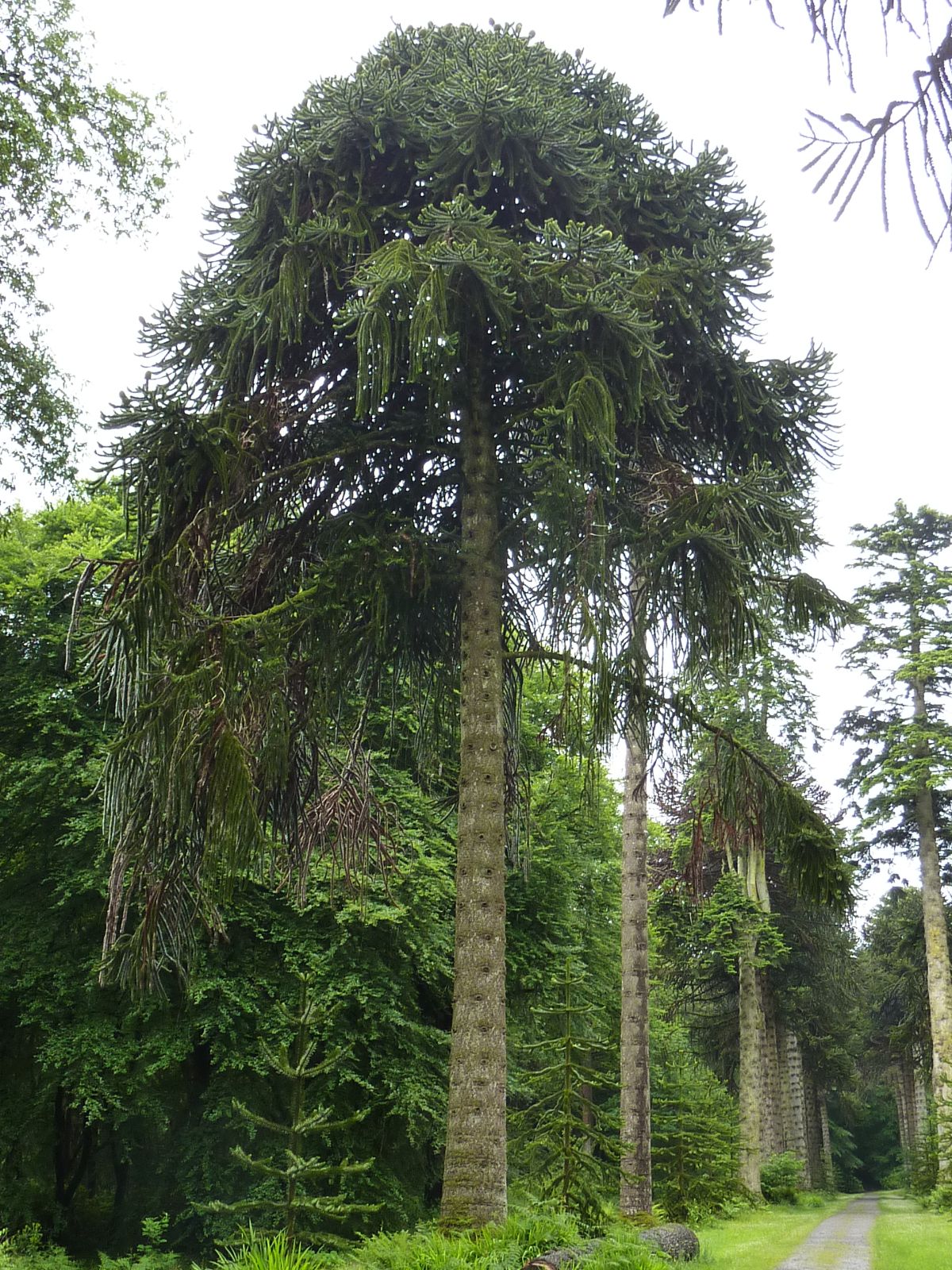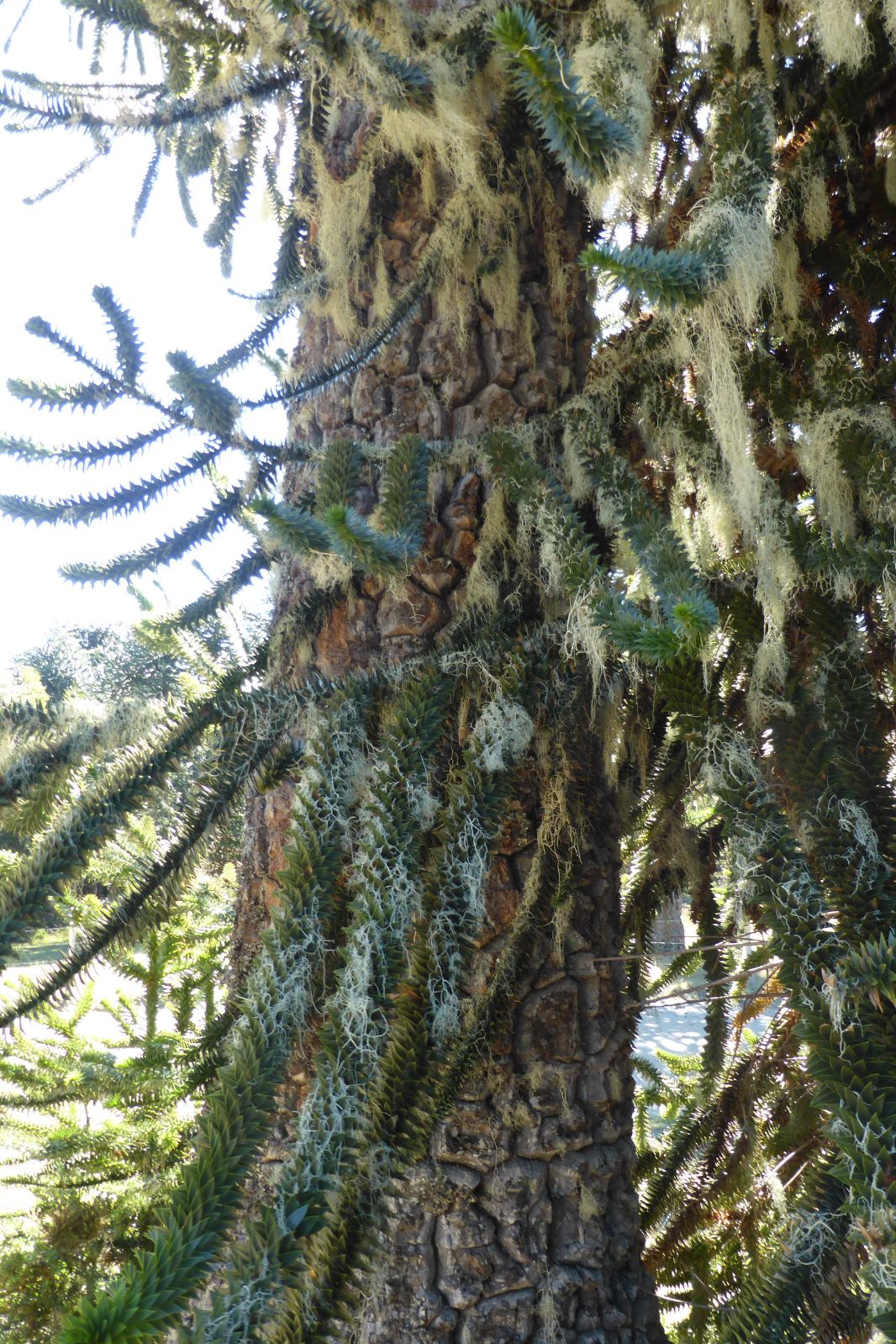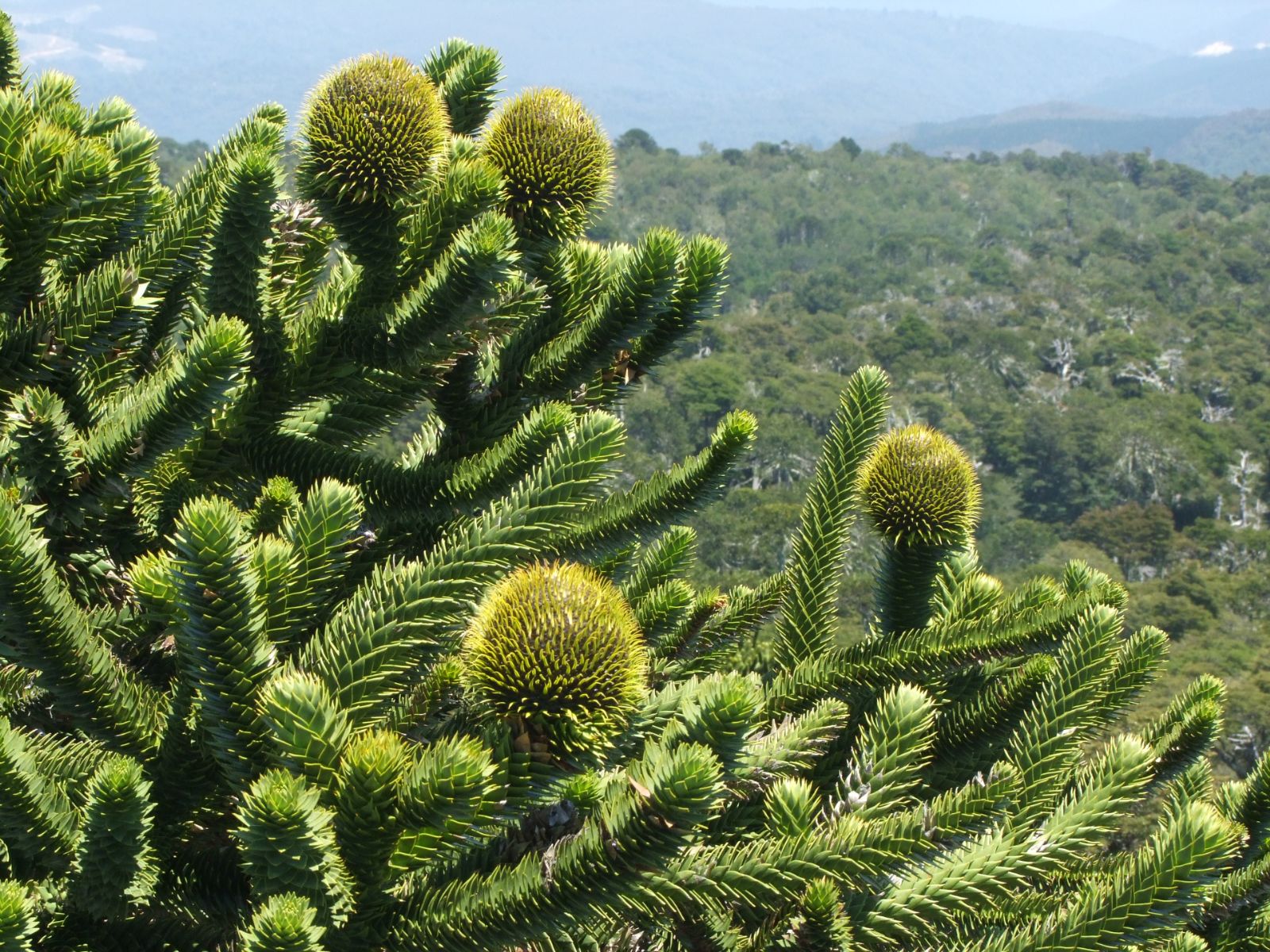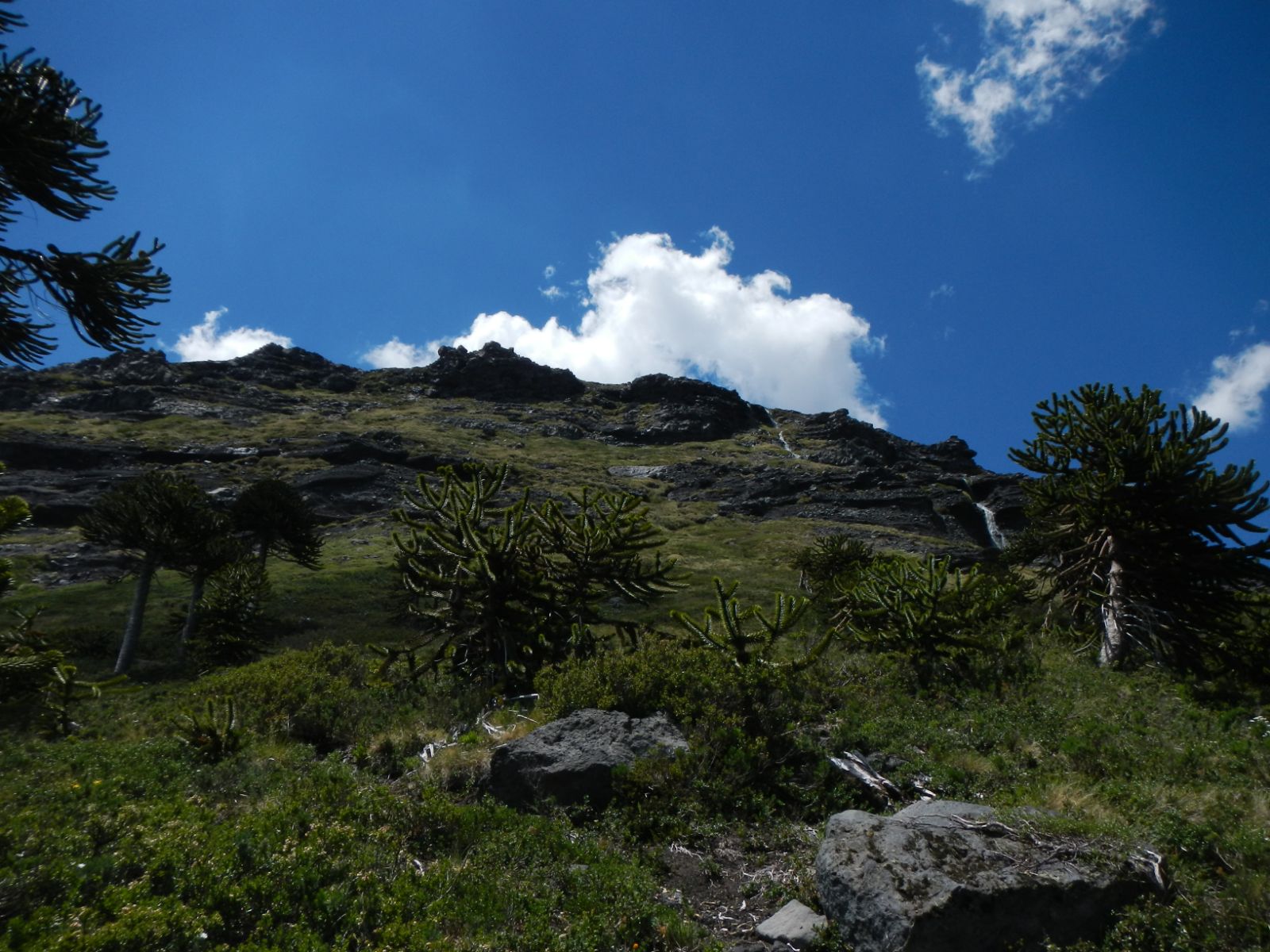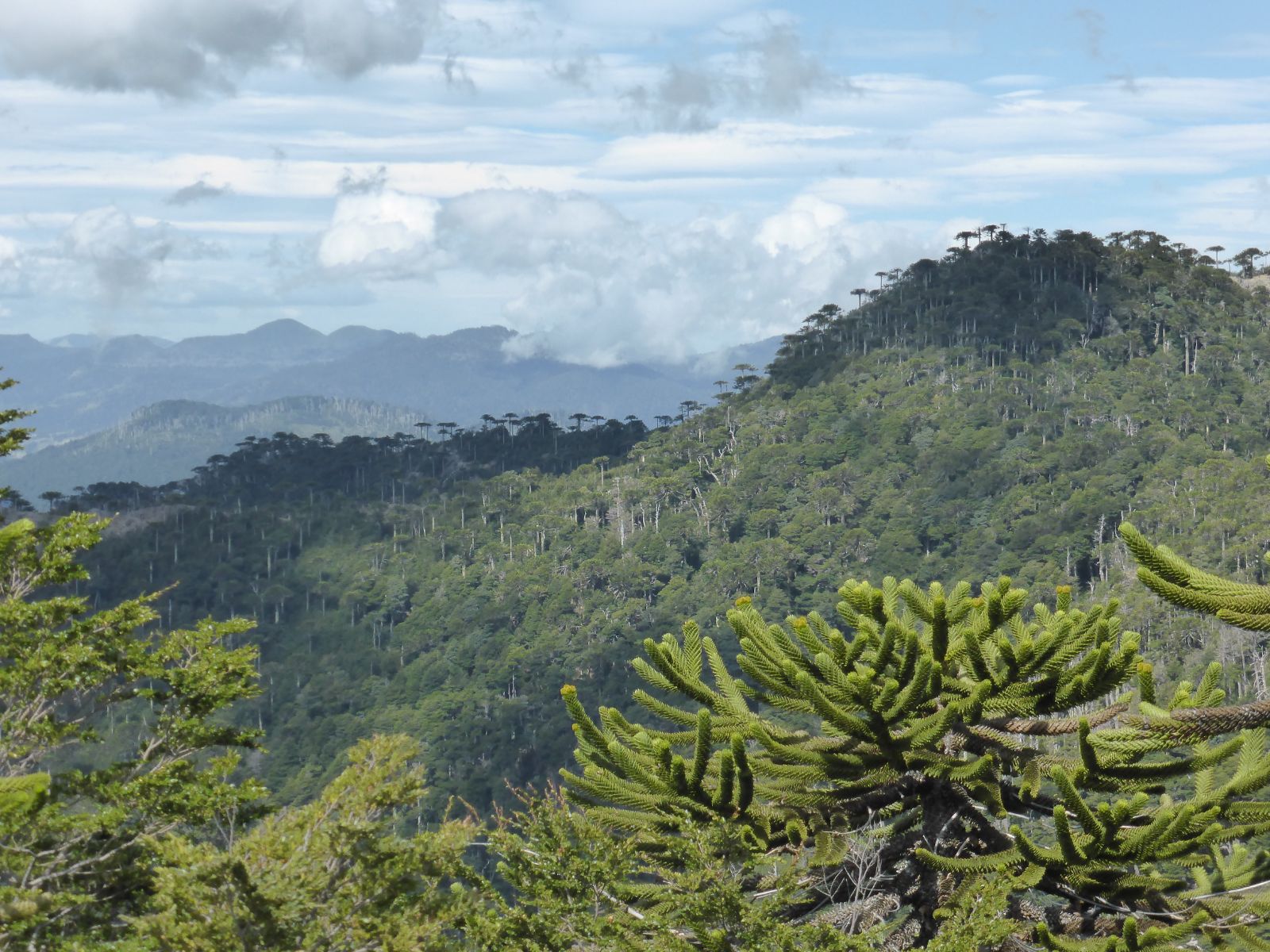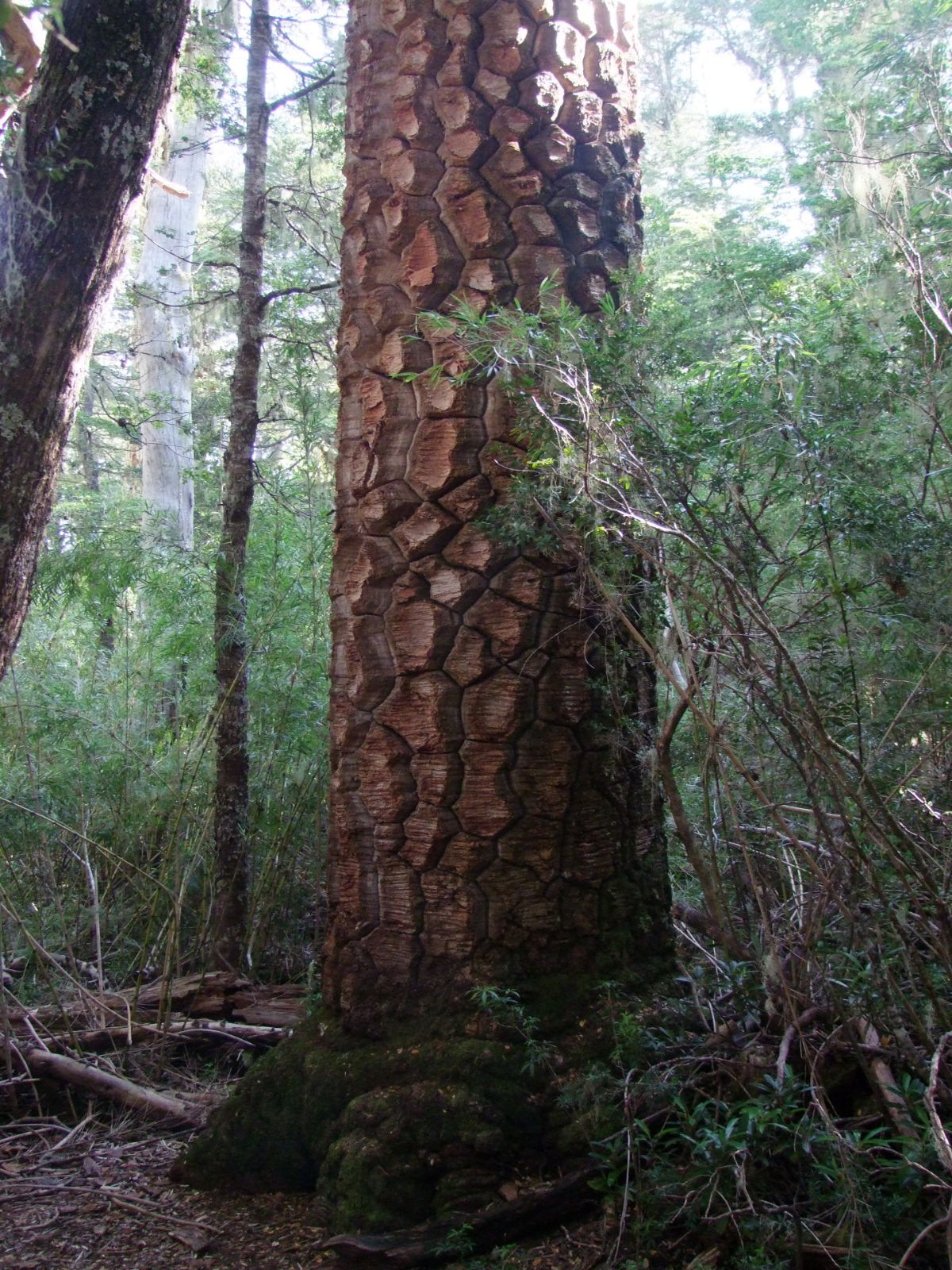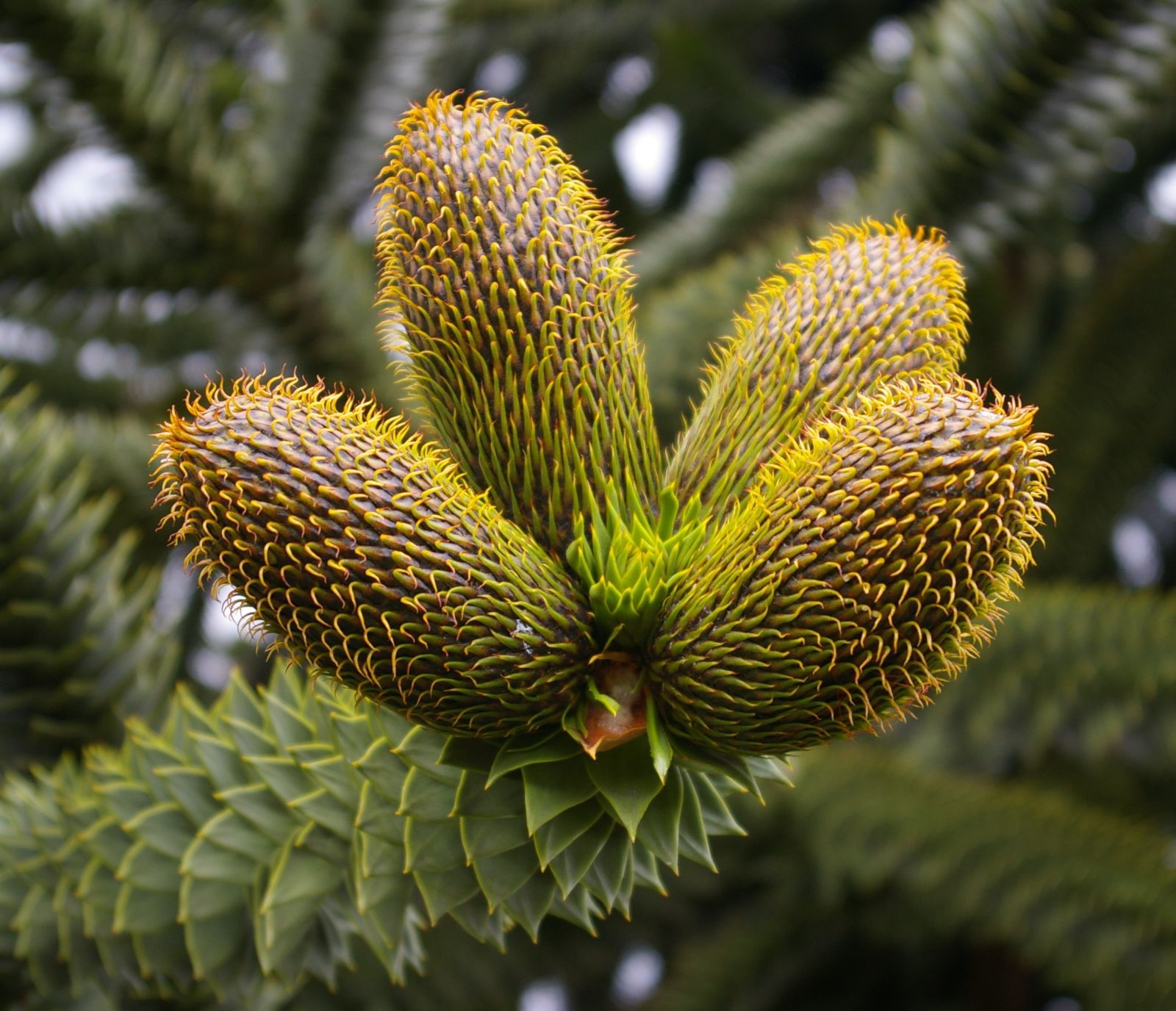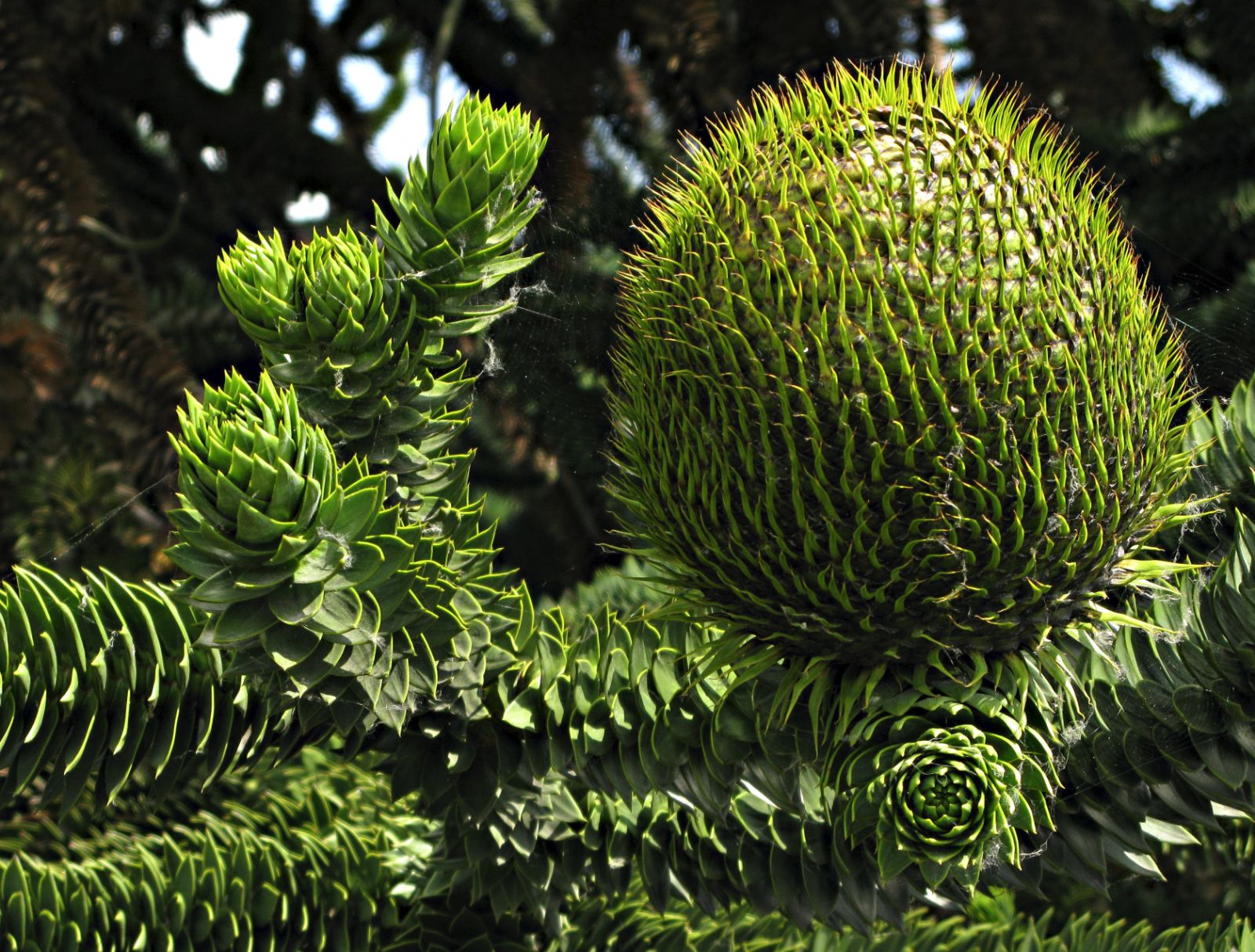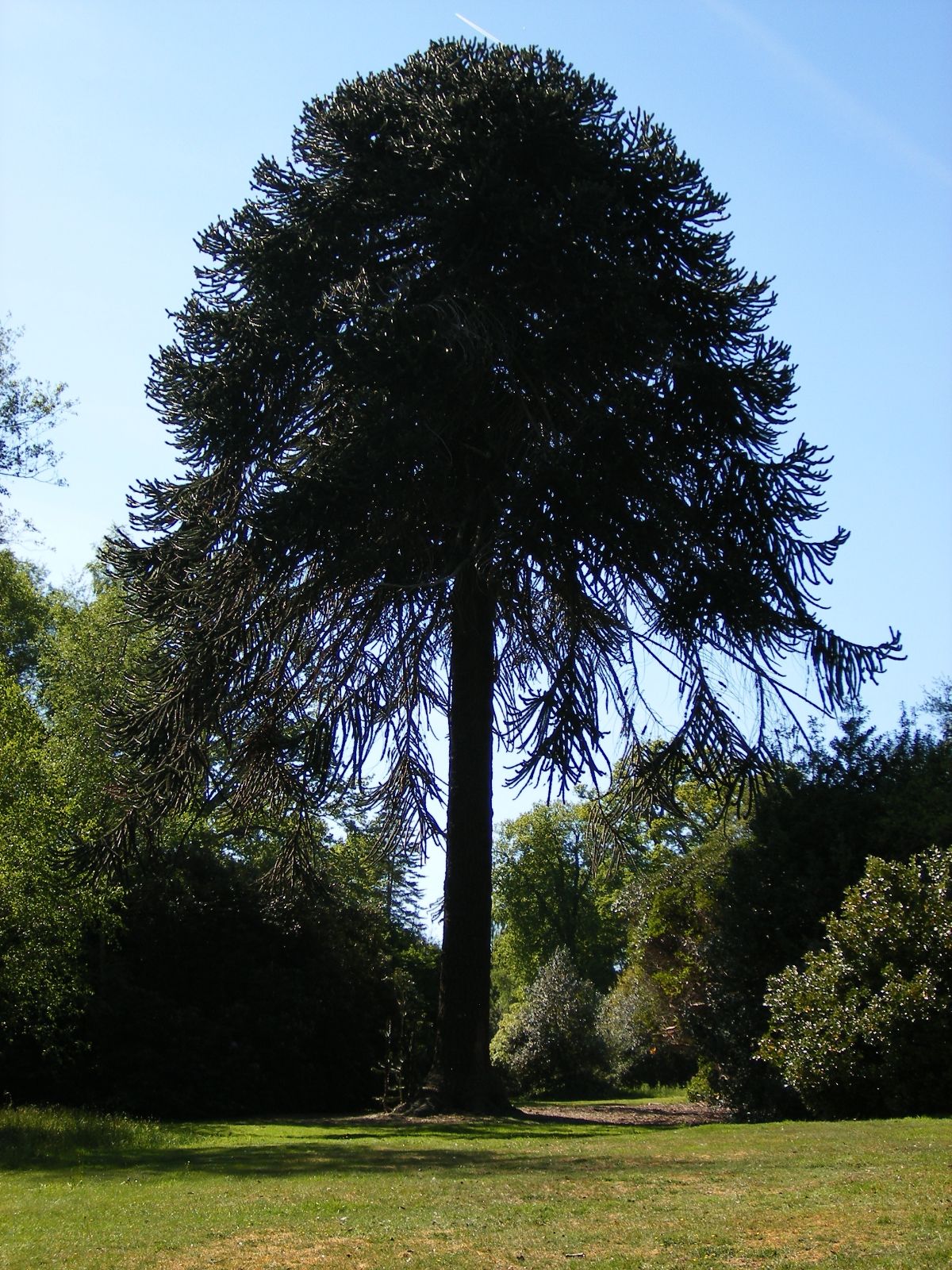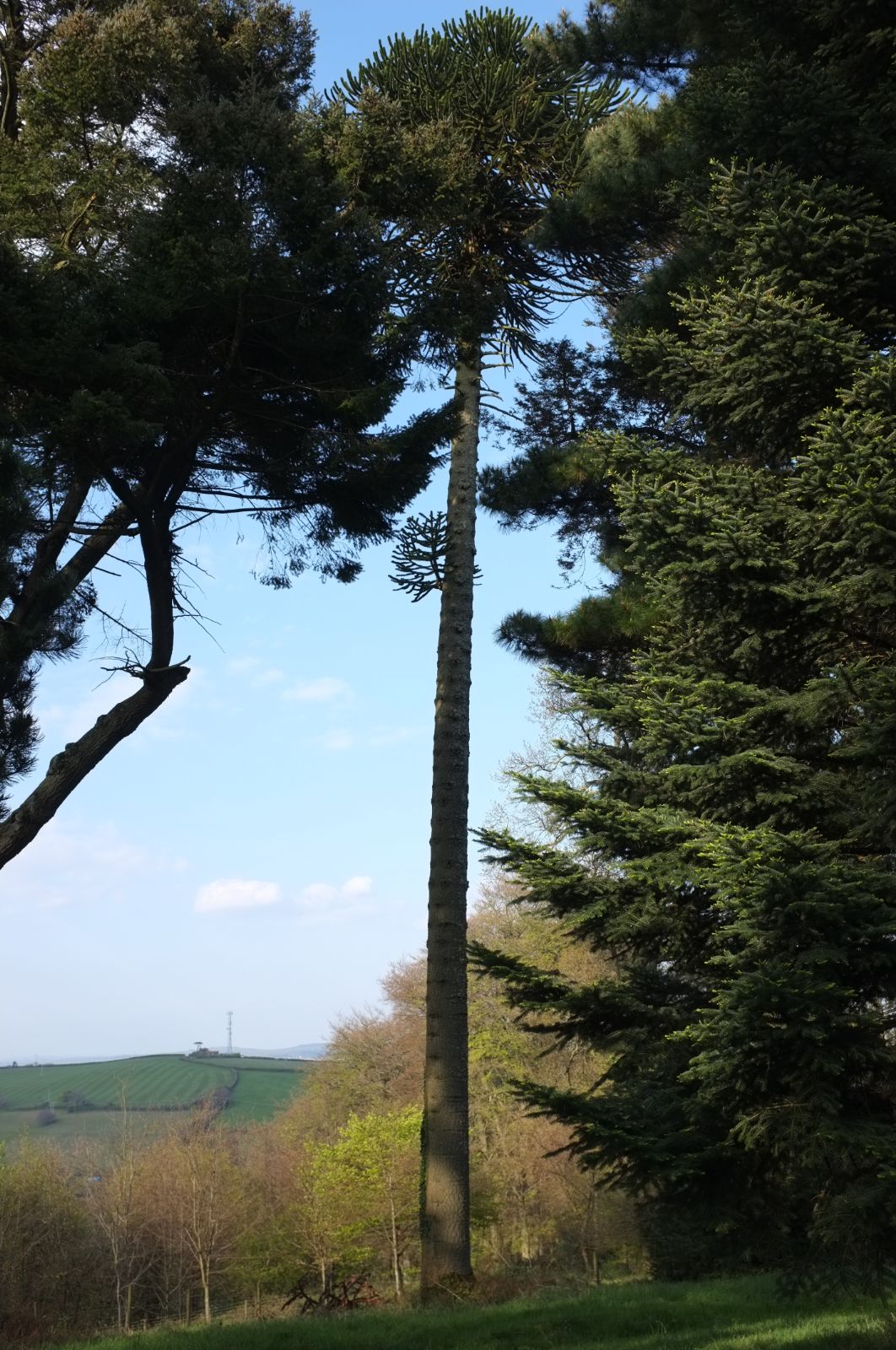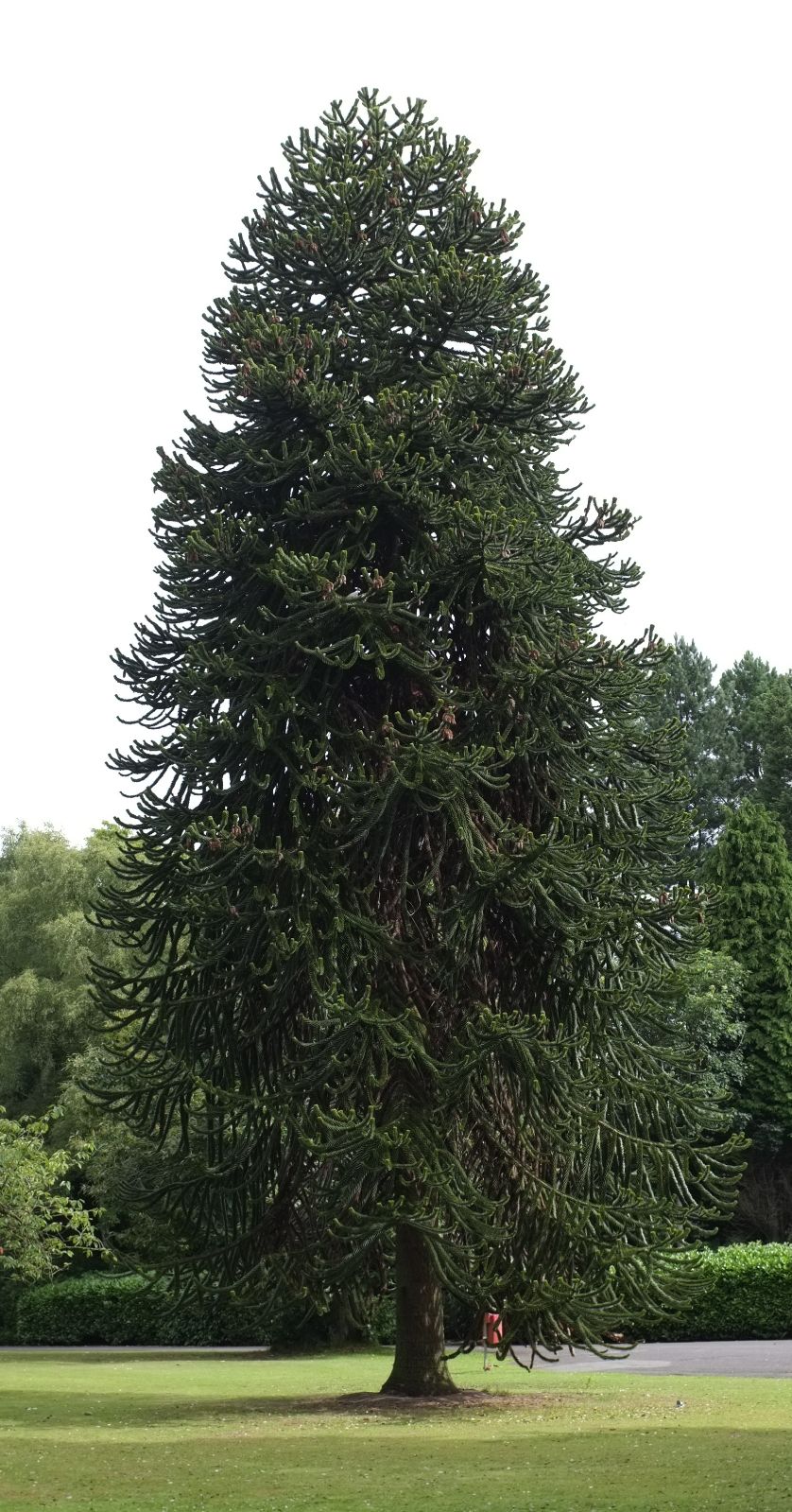Araucaria araucana
Sponsor
Kindly sponsored by
Harriet Tupper
Credits
Tom Christian (2018)
Recommended citation
Christian, T. (2018), 'Araucaria araucana' from the website Trees and Shrubs Online (treesandshrubsonline.
Genus
Common Names
- Chile Pine
- Monkey Puzzle
- Pehuén
- Désespoir du singe
Synonyms
- Araucaria imbricata Pavon
On the slopes of the Chilean Andes wild Pehuén can exceed 50 m in height and can achieve a dbh of up to 2 m while living for up to c. 2000 years. In cultivation in the UK, Ireland, and those parts of Western Europe influenced by the gulf stream, trees might exceed 25 m height × 1.2 m dbh but elsewhere it is usually c. 17–22 m × 0.6–1 m dbh. They are evergreen, dioecious (rarely monecious) trees with a broadly pyramidal crown. Leaves 2.5–6 cm, sessile, triangular-ovate, leathery, rigid, spine-tipped, with stomatal bands on both surfaces. Foliage is spirally arranged, radially outspreading, with leaf bases densely overlapping along the branches. The leaves persist on woody branches and the trunk for many years, remaining sharp and rigid in-situ even after the leaves die. Male pollen cones are 8–12 cm × 4–5 cm, borne terminally on the branches, ultimately pendulous, with exserted and reflexed scales, drying to a pale brown. Female seed cones take two years to mature, are also borne terminally, but remain upright until disintegration, 15–20 cm across, globose, with long-pointed bracts exserted, outspreading at base, then erect, then nearly adpressed to the cone in the upper half. Each cone contains c. 120–180(–200) seeds which are each 4–5 cm × 1.5 cm, obconical-oblong or cuneiform, pale brown. (Gardner, Hechenleitner & Hepp 2015; Debreczy & Rácz 2011).
Distribution Argentina Neuquén Province Chile Region VIII (Province Biobío) south to Region X (Province Valdivia), mainly in the Andes but with a small sub-population in the coastal Cordillera de Nahuelbuta.
Habitat In the Andes from (600–)900–1800 m asl, often reaching the tree-line, on volcanic soils. It most commonly associates with Nothofagus pumilio but also N. antarctica and N. dombeyi and the conifer Saxegothaea conspicua.
USDA Hardiness Zone 8a
RHS Hardiness Rating H5
Conservation status Endangered (EN)
The story of the introduction of Monkey Puzzle’s to cultivation in the British Isles is legendary. The traditional tale is that while sailing as surgeon under Captain Vancouver, Archibald Menzies attended a banquet hosted by the Governor of Chile. Menzies is said to have pocketed some unusual seeds from the dining table, germinating them aboard ship on his return voyage to England, where he landed five or six living seedlings in 1795 – some thirteen years after the species had first been formally described to science by Molina under the name Pinus araucana.
However, this enigmatic tree had first caught the attention of visiting Europeans many centuries earlier when Pedro Mariño de Lobera (1528–1594), a soldier who travelled to the Americas in 1545, documented it in his Chronicle of the Kingdom of Chile, a work that would not be properly published until 1865. The book states that “the number of these trees is so great in all those groves and forests they are enough to give provision to all those [indigenous] people, who are innumerable, so much that they make bread, wine and stews from [the seeds]” (Mariño de Lobera 1865). The use of Monkey Puzzle seeds as a staple food in the indigenous diet is well known and one that continues to this day (Gardner, Hechenleitner & Hepp 2015). Most interestingly, Mariño de Lobera adds a reference to their peculiar white sap: “also distilled from them great abundance of white resin very medicinal for various diseases, especially to take cold and make bizmas [sic]”.
De Lobera’s account also refers to some fallen trees measured at 270 ft (82 m) long, and while trees of such enormous size might once have existed in forests on better ground that have now been lost to deforestation and subsequent land use change, it is likely that this is an exaggeration, or that de Lobera’s “feet” might refer to human rather than imperial feet! In the remaining old-growth forests it can still exceed 50 m height, and there are trees in Reserva Nasampulli in the Andes just shy of 60 m (pers. obs.) although an ultimate height of 40–50 m is more commonly cited in literature.
While the bulk of the tree’s global population is to be found in a relatively restricted area of Chilean Andes and adjacent Argentina, it also occurs closer to the Pacific coast in Chile’s Cordillera de Nahuelbuta (Gardner 2016). In the Cordillera Monkey Puzzle still makes a tree at the highest points within the National Park, and there can be few finer arboreal experiences that sitting on the amazing rock formations at Piedra Del Águila, surrounded by the canopies of Monkey Puzzle trees, waiting for a dinosaur to appear among the lichen-clad trunks as the sun sets toward the Pacific Ocean. Extraordinary though these forests are it is in the Andes that the species reaches its zenith, forming dense, lush forests of towering trees, as they do around Laguna Conguillo in the eponymous national park where they also occur right up to the tree line, as can be seen on the popular sendero Sierra Nevada at c. 1500 m asl. The approach by road to such locations offers tantalising views of the distinctive parasol silhouette of Monkey Puzzles on distant ridges, but such views pale in comparison to those afforded by the high-altitude hiking trails in these mountains which can afford truly breathtaking views out over the lush green forest, over the slopes and ridges of adjacent mountains, all covered with Monkey Puzzles, to distant snow-capped volcanoes soaring into skies of the most intense blue. The whole scene is utterly captivating, instilling a sense of wonder and humility. It is a pilgrimage that every Monkey Puzzle ‘hater’ should make once in their lifetime in order to be converted.
We do not know if the earliest collectors of Monkey Puzzle were motivated by the beauty of the species, or merely its botanical eccentricity. The earliest plausible reference to Monkey Puzzle’s introduction to Europe refers to Johan-Maurits, Prince of Nassau-Siegen (1604–1679) introducing or receiving “seeds which he grew into trees in the 1650s, on his estate near the Holland-Germany border” (Jacobson 1996). Further research on this is needed, but it is true that on his return to Europe in 1644 van Nassau created extensive gardens around Cleves, which would have included glasshouses for the fashionable cultivation of tender exotics. He was Governor of Dutch Brazil, but there is little evidence that he ever travelled to the Andes. As Governor, he did re-supply a force sent from Holland in early 1643 to settle the Chilean city of Valdivia after it had been abandoned by the Spanish, but the expedition failed and returned to Brazil in autumn of the same year (Wikipedia 2018). Even if the expedition had included naturalists, and even if they had sourced Monkey Puzzle seeds, and even if these had not been put to culinary use by a hungry expeditionary force, it is highly unlikely they would have remained viable at the end of the long voyage home via a stopover in Brazil.
Could a more plausible explanation for these vague references to the cultivation of an Araucaria in 17th century Europe be found in Monkey Puzzle’s cousin, A. angustifolia, a native of south-eastern Brazil, southern Paraguay and north-eastern Argentina, where it once formed extensive forests? Van Nassau is more likely to have travelled to this region and to have seen these forests than he is to have reached the Andean forests of A. araucana, so could the trees cultivated by van Nassau, perhaps in his glasshouses, have been A. angustifolia? This theory is, possibly, supported by some confusion that existed around these two species well into the 20th century. A. angustifolia was published in 1898, but it had been recognised as distinct from at least 1819 (Farjon 2001). Later, forms of A. araucana thought to differ from the type were described by Dallimore in 1948, who most unhelpfully gave these the rank and name var. angustifolia; this was still being treated as a form as late as 1996 (Jacobson 1996) but it is now generally treated as a cultivar, if at all. It is easy to see how commentators could easily confuse the identity of these two species when consulting early literature.
Besides this troublesome example, various other morphological variations are known to occur within Monkey Puzzle which have resulted in the naming of several cultivars, many of which were described from plants cultivated in Britain in the late 19th century; these were joined by several more from Europe through the 20th century (Hatch 2015). However, the difficulties involved in the vegetative propagation of Monkey Puzzle mean that many of these plants have probably died out; furthermore, as the natural variation of the species has become better understood, the wisdom of naming selections has been called into question. ‘Aurea’ is a name that does seem to have persisted, and efforts are underway to propagate a fastigiate form growing in a garden in Surrey, UK (J. Grimshaw pers. comm. 2018). A hybrid between A. araucana and A. angustifolia exists and is discussed separately.
Propagation is generally by seed, the knowledge and skills required to propagate them vegetatively having long been forgotten. Monkey Puzzle seeds are infamously recalcitrant and must be sown fresh in order to achieve good germination. It is possible that in the future micro-propagation technologies will improve the feasibility of vegetative propagation, though for a species that grows readily from seed produced even on cultivated trees, this lengthy and expensive approach is unlikely to be employed except in special cases. Such an example may have been the repropagation of Menzies’s original introduction to Britain, were these trees still extant. One of Archibald Menzies’s 1795 seedlings is known to have survived at Kew until 1892, and for many years it has been assumed that the species remained exceedingly rare in cultivation until William Lobb introduced it in quantity to the Veitch nurseries in 1842. However, a new paper dispels this myth (and the one about Mr Menzies pocketing seeds from his host’s dining table in Chile!) and provides much needed clarity to the story of the early introductions to Britain (Gedye 2018).
Gedye does not dispute that the credit for the original introduction to Britain rightly belongs to Menzies, but he provides compelling evidence that Monkey Puzzle became well established in cultivation, and available in significant quantity from multiple sources, well before William Lobb’s famous introduction. To begin with, we now know that in the first few years following Menzies’s introduction horticulturists at Kew perfected the technique for rooting new Monkey Puzzles from his collections, and distributed plants of the new and rare curiosity to a few notable collections in Britain and in Germany. More significant though is the light Gedye shines on the oft-overlooked contribution of James McRae, who was dispatched to Hawaii via South America by the RHS in 1824, tasked with securing seeds of Monkey Puzzle during his stop overs in Chile. McRae was successful not only in acquiring a collection of seed which he returned to Britain in person, but also in securing a regular supply of further shipments from corresponding members of the RHS in Chile, so that by the time of his return in 1826 there was “a network in place to supply Chilean sourced seed to both the Horticultural Society in London and Glasgow Botanic Garden” (Gedye 2018). The RHS distributed specimens from the McRae collection to the major botanic gardens in Britain and Ireland, as well as to influential members and supporters, and within only a few years several commercial nurseries were also advertising the availability of Monkey Puzzle in quantity, raised from seed sent by correspondents and agents in Chile. All of this suggests that rather than being instrumental in the introduction of the species to Britain, the Veitch nurseries were relatively late to the party, only commissioning Lobb to collect the species in 1839 once its horticultural merit and commercial value had been well established.
Knowing that Monkey Puzzle was introduced in quantity in the years preceding Lobb’s visit to Chile, we are forced to question the legitimacy of the claims that so many mature Monkey Puzzles in Britain are derived from Lobb’s introduction, Unless records survive which demonstrate the Veitch and/or Lobb connection, such claims cannot be substantiated based on the planting date alone. Curiously, in his collated essays on the Woods, Forests, and Estates of Perthshire, Thomas Hunter remarks on several A. araucana growing at Abercairny in that county and suggests these ‘are said to have been raised from seed procured at Bicton, Devonshire, and believed to be the first araucaria seed successfully raised in this country’ (Hunter 1883), which suggests that cultivated trees planted en-masse were producing viable seed in fewer than 40 years (the famous avenue at Bicton was planted in 1844).
More recent introductions include those made by the Royal Botanic Garden Edinburgh’s International Conifer Conservation Programme (ICCP) between 1998 and 2001, which are growing in quantity under various collector numbers at locations including Benmore Botanic Garden and Kilmun Arboretum in Argyll, Torosay Castle on the Isle of Mull, the Eden Project and the Tregothnan Estate in Cornwall, as well as in smaller numbers at dozens of other locations (Royal Botanic Garden Edinburgh 2007–2008). After several years focussing on other priorities the ICCP made another significant introduction from the Reserva Nasampulli in 2017, resulting in several hundred seedlings that will be distributed through the ICCP’s safe-site network in the coming years. An introduction from the Cordillera de Nahuelbuta in 2009 by Bedgebury National Pinetum and the Millennium Seed Bank under the number CHIX 84 has been grown on and planted at locations including Benmore, Bedgebury, Westonbirt, Wakehurst, Kew, and Craigvinean Forest, Perthshire.
Besides these wild-sourced introductions, the species has been available commercially since the late 1830s, and continues to be planted sporadically by gardeners both on a domestic scale and on a grand one, the latter exemplified by the new 304 m long avenue planted at Kilmacurragh, Co Wicklow, Ireland, in 2014 using plants grown from seed taken from a mature tree in the garden (itself of uncertain origin) (S. O’Brien, pers. comm. 2018).
Of the innumerable mature trees growing in the UK and Ireland, The Tree Register (Tree Register 2018) records a handful of trees with known planting dates in the 1830s and a single tree planted in Cumbria in 1815, but in these cases the trees have not been re-recorded for at least the last 15 years. There are several extant records with planting dates in the 1840s, including the famous avenue at Bicton (1844) but in recent years, and particularly in the milder, wetter areas of western Britain, old trees have shown acute sensitivity to environmental stresses, particularly associated with high or fluctuating water tables, which weaken the trees generally and can increase susceptibility to infection by diseases such as Phytophthora.
Aside from these emerging diseases affecting older or stressed trees, Monkey Puzzle seems to be relatively trouble free. They dislike being moved and should be planted young, and cultivation in Air-Pot® containers will help to keep the root system healthy and reduce shock when re-potted or planted. In containers, it is helpful to incorporate some soil taken from near the base of healthy, mature trees (pers. obs.). They are broadly tolerant of a wide range of environmental conditions and young trees are performing well on shallow, peaty soils in Argyll, but they are at their best on deep fertile soils with good drainage, and whilst young trees will tolerate shade, they will not thrive in it. It is a good tree in coastal gardens and can tolerate exposure in such areas, as well as in all but the harshest parts of upland Britain.
Elsewhere it would seem to be limited both by extremes of winter cold and summer heat, although it has been cultivated in the Faroe Islands where unsurprisingly it grows very slowly (Ødum, Hansen & Rasmussen 1989). It is also cultivated on the west coast of North America, the largest listed by Jacobson (1996) being a 23 m specimen at Holberg, British Columbia, though he lists several smaller examples in Washington and Oregon states. It may also be found in appropriate climatic zones in south-eastern Australia and New Zealand. It is infrequently encountered through much of continental Europe, but does occur in areas where there is a maritime influence on the climate, such as in south-western Norway where it grows in collections around Stavanger and Bergen and has been recorded exceeding 22 m in height, having been introduced to this area in the early 1860s (Søndergaard 2004). There are records of trees exceeding 20 m height on the Rhederoord Estate in the Netherlands, and in a private garden near Clermont-Ferrand, France. The French example exceeds 1 m dbh, as does another at Pettinengo in northern Italy, and many examples are known from Belgium and north-western Germany (monumentaltrees.com 2018). It is conspicuous by its absence throughout much of Mediterranean Europe where the high summer temperatures and low rainfall appear to be limiting factors, but in southern Europe it may occasionally be found at higher altitudes where it can escape the most intense summer heat.
The best trees in cultivation are doubtless those in the mild oceanic climate of the UK and Ireland. Experience here shows we can expect it to achieve c. 20 m height and 0.5 m dbh by maturity in any reasonable situation, and there is barely any area of these islands – except perhaps areas of the Scottish Highlands and other extensive uplands – where one can travel many miles without seeing a specimen. As of 2018 there are so many trees throughout the UK and Ireland that exceed 25 m height and 1 m dbh that only the most exceptional examples can be singled out. Trees known to exceed 30 m in height in cultivation are recorded at Caledon Castle, Co Tyrone, Ireland, and at in a private garden near Petersfield, West Sussex, and in another near Dawlish, Devon. A tree in the avenue at Bicton, planted in 1844, was 29 m tall when last measured in 2013. The tallest in Scotland is a 28 m tree growing in the avenue at Castle Kennedy, Wigtownshire. The largest recorded girth in cultivation is also on an Irish tree at Lough Fea House, Co Monaghan, measuring 1.38 m dbh, though only two other trees are known to exceed 1.3 m dbh, one in the avenue at Bicton and another in the grounds of Whittington College, Surrey (Tree Register 2018).

